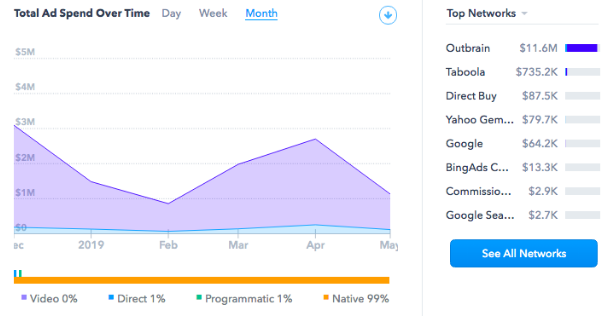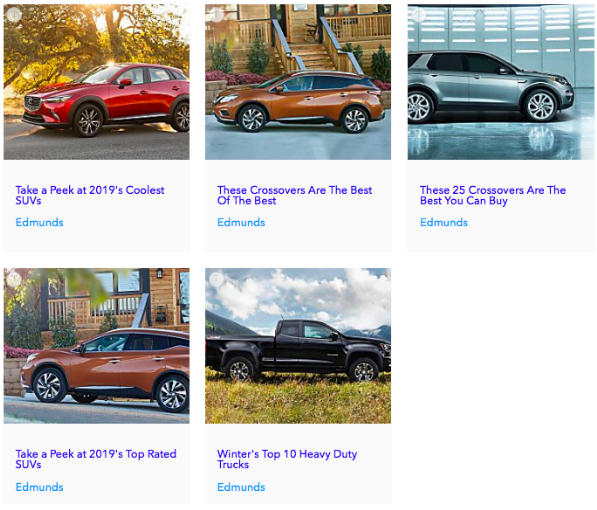Founded in 1966, Edmunds is a one-stop online resource for automotive information including car prices, dealer inventory listings, national incentives database, and vehicle comparisons. Using images, videos, news articles, blog posts, and discussion boards, the company caters to users looking to learn more about SUVs, sedans, minivans, wagons, trucks, luxury cars, coupes, crossovers, electric cars, and hatchbacks.
Over the years, Edmunds has launched: a free online magazine for auto-enthusiasts, Car Week—a week-long event to connect car dealers with customers, a True Market Value Used Vehicle Appraiser that displays the actual transaction prices for used cars, and a hackathon event called Hackomotive to invite new ideas to scale the company.
In their first-ever TV commercial that aired in 2012, Edmunds introduced the character of the ‘Car Head’—a company representative with a car for a head—who encourages consumers to avoid haggling with car dealers by using the company’s ‘Prime Promise’ tool to compare vehicle costs to secure the best deals.
According to Datalogix, 59% of U.S. car buyers use Edmunds while making a purchasing decision, and more than half of their website visits actually result in a conversion.
Let’s take a closer look at their overall advertising strategy:
Ad Spend and Ad Networks
In the last 6 months, Edmunds has spent a whopping $12.6M on online promotion of their brand, with the majority being dedicated to Outbrain ($11.6M), content distribution and native advertising platform. Additionally, Taboola ($735.2K), Direct Buy ($87.5K), and Yahoo Gemini Native ($79.7K) are also advertising networks that they’ve invested in.
By comparison, Kelley Blue Book (KBB), a direct competitor to Edmunds, also invests heavily in native advertising with an ad spend of $9.5M on Taboola and $1.9M on Outbrain for the same time period

Almost 99% of their ads are native—most of which run on mobile devices and have a 406% chance of a higher click-through-rate (CTR) than banner ads.
Why, you ask? Simple!
Banner ads are intended to show up at a designated place. On small screens, this can often interrupt the surrounding messages and in turn, the overall user experience of the platform they’re displayed on. On the other hand, native ads tend to blend in with the look, feel, and style of the website; and offer a distraction-free value proposition to the consumers.
In an attempt to close intrusive ads, most people end up accidentally clicking on them—which is fairly understandable, keeping in mind the touch screen nature of smartphones. On the contrary, the clicks on native ads are a result of genuine interest and have a higher chance of a conversion.
Publishers
From the very beginning, Edmunds has stuck to advertising with the same publishers—CNN ($1.5), Rolling Stone ($980.9K), ESPN ($617.6K), The Hill ($393.7K) and Daily Caller ($379.7K). They’ve also advertised with The Verge ($334.7K), SBNation ($331.6K), Politico ($307.9K), Fox News ($298.4K), and Curbed ($252.1K).
Quick side note: Kelley Blue Book uses more or less the same publishers as Edmunds. CNN ($256.2K), Slate ($245.3K), NBC News ($222.1K), Android Central ($219.1K), and NBC Sports ($186.1K) have been their top publishers in the last 6 months.

On CNN, the ads appear largely on the homepage and on posts that fall under the ‘tech’, ‘business’ and ‘success’ category. One can assume that these pages get reasonable traffic, which explains why most of Edmunds’ ads have been running on and off with the same publishers for more than 600 days.

Kelley Blue Books takes a slightly different approach while advertising on CNN. Although, their ads appear under the same categories as Edmunds—technology and money, they tend to be featured next to the video news section of the platform, as opposed to the plain-text articles.
Similarly, on Rolling Stone, Edmunds’ ads are displayed on posts under two specific categories—movies’ and TV—whereas, on ESPN the ads can be seen on posts under the racing, MLB, and NFL categories.
Creatives
Given that Edmunds relies heavily on native ads for promoting their services, it comes as no surprise that 89% of their ads are text/image based.

Since Edmunds makes revenue from car dealerships looking to advertise, they don’t really have any discounts to offer to the buyers. By saying, ‘Take a Peek at 2019’s Coolest SUVs’ or ‘These 25 Crossovers Are The Best You Can Buy’, the company is able to draw an average user’s attention by telling them something interesting and extending an invitation to learn more.

Considering that native ads are more likely to receive twice as much visual focus than banner ads, it’s important for brands to use this opportunity wisely when designing in-feed creatives. Edmunds is very straight-forward with their images. Most of them include an automobile (cars, trucks, etc.) that’s relevant to the headline and communicates exactly what the brand is about.
The ads clearly reflect the content’s purpose and core message, without being click bait-y or misleading in any way. For any kind of ads to work—including native, it’s important that people trust your brand from the get-go, and they’d quickly lose interest if you’re deceiving them into visiting a landing page or buying your product.
Landing Pages
Instead of directing traffic to their homepage, Edmunds’ native ads lead to dedicated landing pages on the website. For example, an ad saying, ‘Best Sedans for 2018 & 2019 – Reviews and Rankings’ takes the user to the following landing page that contains:
- Reviews, specs, inventory, and photos of different Sedan models.
- Price of different types of Sedan.
- Buying guides for Sedans.
- Sedan videos.

Every section has a single call-to-action (CTA) that redirects to a separate landing page that has more information about the specific topic that the user is interested to know more about. The CTA copy (for example, ‘Read Buying Guide’ or ‘Research Sedans’) is short and simple, but can be more compelling and persuasive than it is right now.
Remember, as Neil Patel rightly puts it, “Your homepage is a hub. It’s a jump-off point to the rest of your site’s content. A landing page is a destination. It’s where you want visitors to end up.”
When you send visitors to your homepage, you’re sending them on a quest to navigate your website and find the landing pages that interest them. They’re seldom going to convert, when the onus of responsibility is on them.
Therefore, it’s a business imperative to make sure that the very first page they see when they stumble upon your platform, plays an extremely pivotal role in convincing them to dedicate their time and attention to what you’ve to offer. Something KBB can also learn from, given that all their ads lead the homepage in most cases.
Currently, there’s no sign-up prompt on the landing page, that can help customers stay-up-to-date on Edmunds latest products and services. By encouraging users to join the platform, a brand can easily build an email marketing list that can be used to relay for e information about the company, including any ongoing offer, to the customers.
Conclusion
Almost the entirety of Edmunds’ ad spend goes towards native ads—something most brands can actually take notes from. On average, customers are 25% more likely to look at native ads than display ads, and see an 18% increase in purchasing intent after viewing the former. Despite some obvious challenges related to dynamic size variation, content orientation, viewability measurement, or programmatic vendors, more marketers should embrace the benefits of native ads and consider incorporating them in their long-term marketing strategy.
For Edmunds, native advertising has clearly worked wonders, which explains why they continue to invest in it.
The creatives are high-quality, relate closely to the headline, and accurately represent what the company has to offer. A well-designed, to-the-point landing page is easy to navigate and steers users exactly in the direction that you want them to take. The copy on both the ad and landing page tells people what they want to know in as little words as possible.
Overall, Edmunds are aware of the publishers that yield them actionable results, and the ad placement that leads to maximum CTRs. They seem to have figured out how to optimize their advertising to get the best possible outcome.